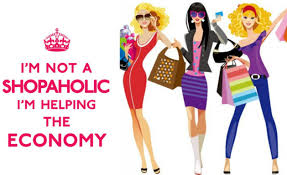Shopping addiction actually has a technical term that is called Omniomania. This means compulsive shopping and is perhaps the most socially reinforced of the behavioral addictions. Shopping addiction is characterized by the widespread desire to shop and purchase items despite a need for such items or despite a necessary ability to afford such items. Consumerism is one of the biggest measures of social elite in America and this makes shopping addiction an even more widespread problem for many.
Shopaholics, also known as compulsive shoppers or shopping addicts, may actually be suffering from a psychiatric disorder known as compulsive buying disorder.
Compulsive buying disorder (CBD) sufferers have a sense of excitement before a purchase, an inability to resist the urge to shop and a rush or sense of reward while spending, despite any negative consequences of their actions. CBD is considered an impulse-control disorder. Just as with other impulse-control disorders such as drug and alcohol addiction and pathological gambling, for many compulsive shoppers the “high”of the spending spree is followed by a low, where the powerful euphoric feelings are replaced with those of distress, shame and guilt.
Shopping addiction is not a newfound disorder. It has affected millions of people for many years and dates back to as early as the 19th century. Friends and family members go out and shop together, people shop socially, people shop for something to do and people shop to fulfill negative emotions. An addiction to shopping leads to compulsive shopping that can result in many negative feelings. According to the US National Library of Medicine, over 5% of Americans are affected by compulsive buying disorder.
While some of us may enjoy the thrill of an occasional splurge or scoring a good deal, spending more than you bargained for during an annual holiday shopping spree doesn’t automatically make you a shopaholic. But that thrill, what some shopaholics describe as a high, helps drive compulsive shoppers to want more — excessive shopping, uncontrolled spending sprees and impulse buys are the defining characteristics of compulsive buying disorder.
People who suffer from compulsive buying disorder may also have feelings of anxiety or tension while they try to resist the urge to shop. And unlike those who compulsively shop without regret during the manic periods of bipolar disorder, CBD sufferers often feel depressed or distressed for having given in to the urge and guilty over their growing debts after they’ve gone on a spree. But it can be those very feelings of distress, shame and depression that ignite the shopping addict to again seek the “high” that comes along with shopping, despite any negative consequences of their actions.
The different types of shopping addictions:
“The Compulsive Shopper”: The compulsive shopper runs on emotion. He/She shops for the euphoric high when angry, distressed, sad, or any other dominant emotion.
“The Trophy Shopper”: The trophy shopper will shop and shop until they find the perfect item, constantly one-upping themselves but never feeling ‘content’.
“The Image Shopper”: The image shopper is preoccupied with how everything they purchase looks to everyone around them. They love flashy and obvious purchases.
“The Bargain Seeker”: The bargain seekers cannot pass up a sale. They are mesmerized by discounts and find themselves purchasing items they don’t need just because they’re on sale.
“The Bulimic Shopper”: The bulimic shopper is stuck in a vicious cycle of purchase and return. They buy items they don’t need, return them shortly later, and then purchase more items only to return them later.
“The Collector”: The collector does not feel fully whole unless they have one item in each color or every part of a set of items.
These are not labels per say, but these different types of shopping addictions stand as a foundation for relatability.
zAs the weather cools and the air turns crisp, US retailers are once again facing challenges for the holiday-shopping season. The past couple of years saw severe, systemic supply chain disruptions and high case rates for COVID-19. However, the landscape is more nebulous this time. Consumer demand has softened, while inventory levels are higher than they’ve been in years, and company earnings continue to face scrutiny from Wall Street as some profits decline.
The average American has about three credit cards and knows how to use them — on average, a cardholder owes almost $16,000 on their plastic [source: Woolsey]. Compulsive shoppers have, on average, the same number of cards as the rest of us but the difference is that they’re more likely to maintain balances between $100 to $500 shy of each card’s maximum limit [source: Koran]. They shop excessively and impulsively, typically making their purchases on credit, stated by McKinsey & Company state.
The National Retail Federation, a trade group for the retail industry, said a record 196 million Americans shopped in stores and online over the Thanksgiving holiday weekend, a 10% increase from last year.
RDI revolution.com states “Offline holiday sales still surpass online sales – and they’ve also grown rapidly. Overall US holiday retail sales reached $843.4 billion in 2021. That’s up from $691.7 billion in 2019!
In 2022, shockwaves from the pandemic will continue to transform consumer shopping habits. Inflation is one such impact, with the annual US inflation rate currently around double what it’s been for the past 40 years.
Retailers can expect shoppers to buy less this year. In fact, the rate of inflation in Q4 may be higher than the rate of holiday sales growth.” (https://roirevolution.com/blog/2022-holiday-ecommerce-stats-trends-predictions/)
Meanwhile, US consumers continue to send mixed signals. Their sentiment about the economy remains historically low, and they still have concerns about inflation. They’re looking for savings by trading down and seeking value where they can find it. But many of them have cash to spend—and they say they’re not just willing but eager to spend and splurge. People in the United States are more excited for the holidays than they’ve been in years.’

